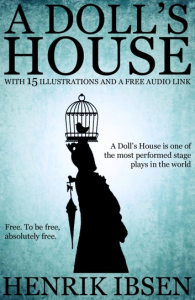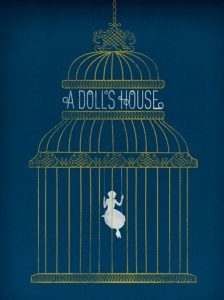Development of Independence:
A Doll’s House and Freedom
By İrem Cansın Yalırgav and Bilge Yalçın

A Doll’s House, a three-act problem play by Henrik Ibsen, was published in 1879. The play centers around a woman who is oppressed by patriarchy in her house. She is not only being oppressed but also restricted economically and psychologically which leads to the violation of her essential freedom. Nora, the protagonist, symbolizes the doll while her house represents the playroom. The story demonstrates that even if a marriage starts with the best intentions, it could end up with bad consequences. To illustrate, Nora gets a loan for Torvald’s treatment, which is a journey to Italy. At the end of this journey, Torvald gets better, nevertheless, he does not know the truth about the debt. After he learns the truth, they get into a quarrel, and she becomes aware of her oppressed position in this marriage.
Ibsen’s play points out how Nora’s independence is restricted by her husband, Torvald. Since Nora’s life resembles a prison life, even the thought of freedom seems miraculous to her. However, considering that she was enjoying her marriage in the first place, she thinks she is happy without knowing that she is manipulated by Torvald. Therefore, she cannot resist her obsession with him as if he is a good man. Because of this manipulation, she is not able to see the bigger picture since her freedom of thought is restricted. Apart from that, even the reason for this debt is a consequence of her invaded economic freedom. Torvald is like a swirl that swallows Nora up; however, step by step she becomes aware of the bad influence of Torvald. Furthermore, he sees Nora as if she is a treasure to him; she is like an object, a thing that belongs to someone; she belongs to him. Admittedly, Torvald never gives Nora a chance to express herself, and even though she does that, he does not accept her expressive self anyway. Ibsen emphasizes the freedom of expression that Nora lacks by Torvald shouting at Nora to silence her. When Torvald learns about the debt, he starts insulting Nora without blinking. He doesn’t let Nora express herself or explain the situation. Plus, he even locks the hall door when they are arguing so that Nora would not be able to escape, and this restricts her freedom.
The confrontation that Nora and Torvald have costs Torvald to lose her when Nora gains her independence, in other words, freedom. Additionally, since Torvald never gave her a chance to speak or express her thoughts, she was not able to educate herself. Before her marriage, her father did the same thing therefore she was not educated. Tragically, her father and husband were manipulative teachers who did not teach but commanded. Due to this lack of education opportunity, she realized everything after a long time. Readers witness the development of Nora’s freedom. Nora became aware of her surroundings; therefore, she decided to break up with her husband and leave this miserable life behind to find her own thoughts and her freedom.

